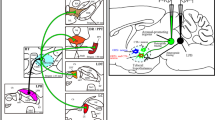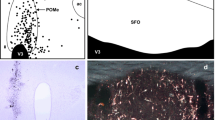Summary
Anatomical evidence is presented for an interaction of ACTH1–39 immunostained fibers and a specific population of hypothalamic paraventricular (PVN) neurons; these neurons project to the dorsal vagal complex (DVC) of brainstem medulla. Bilateral injection of 10% HRP-WGA into DVC is incorporated into nerve terminals and transported retrogradely to cell bodies in the parvocellular subdivision of PVN, as revealed by standard HRP-WGA histochemistry or antibody to wheatgerm agglutinin followed by immunocytochemical techniques. Labeled cells are localized predominantly in the ventral portion of the caudal medial parvocellular subdivision and ventrolaterally in the posterior subnucleus of PVN. Few labeled cells are seen in the anterior parvocellular PVN, rostrally in the medial parvocellular component and in the dorsal cap. HRP-WGA cells are rarely observed in the magnocellular divisions of PVN. Dual-staining immunocytochemical-retrograde tracing techniques in the same tissue section demonstrate ACTH1–39 fibers in intimate anatomical proximity to parvocellular PVN neurons that project to DVC. It is suggested that this interaction may partially account for the known cardiovascular effects of opiocorins and supports the role of the paraventricular nucleus in hypothalamie integration and modulation of cardiovascular control.
Similar content being viewed by others
References
Akmayev IG, Vikhreva OV, Konovalova LK (1981) The origin of the hypothalamic-vagal descending pathway: An experimental ultrastructural study. Brain Res 230:342–345
Armstrong WE, Warach S, Hatton GI, McNeil TH (1980) Subnuclei in the rat hypothalamic paraventricular nucleus. A cytoarchitectural, horseradish peroxidase and immunocytochemical analysis. Neuroscience 5:1931–1958
Berecek KH, Webb RL, Barron KW, Brody MJ (1982) Vasopressin projections and central control of cardiovascular function. Ann NY Acad Sci 394:729–734
Bowker RM, Westlund KN, Sullivan MC, Coulter JD (1982) A combined retrograde transport and immunocytochemical staining method for demonstrating the origins of serotonergic projections. J Histochem Cytochem 8:805–810
Ciriello J, Calaresu FR (1980) Role of paraventricular and supraoptic nuclei in the central cardiovascular regulation in the cat. Am J Physiol 239:R137-R142
Clark A, Downs EC, Primus FJ (1982) An unlabeled antibody method using glucose oxidase-antiglucose oxidase complexes (GAG): A sensitive alternative to immunoperoxidase for detection of tissue antigens. J Histochem Cytochem 30:27–34
Freeman RH, David JO, Fullerton D (1980) Chronic ACTH administration and the development of hypertension in rats. Proc Soc Exp Bio Med 163:473–477
Gruber KA, Klein MC, Hutchins PM, Bucklew VM Jr, Lymangrover JR (1984) Natriuretic and hypertensive activities reside in a fragment of ACTH. Hypertension 6:468–474
Hancock MB (1976) Cells of origin of hypothalamo-spinal projections in the rat. Neurosci Lett 3:179–184
Hancock MB (1982) A serotonin-immunoreactive fiber system in the dorsal columns of the spinal cord. Neurosci Lett 31:247–252
Hornby PJ, Piekut DT (1987) Catecholamine distribution and relationship to magnocellular neurons in the paraventricular nucleus of the rat. Cell Tissue Res 248:239–246
Joseph SA (1980) Immunoreactive adrenocorticotropin in rat brain: A neuroanatomical study using antiserum generated against synthetic ACTH1–39. Am J Anat 158:533–548
Joseph SA, Pilcher WH, Bennett-Clarke C (1983) Immunocytochemical localization of ACTH perikarya in nucleus tractus solitarius: Evidence for a second opiocortin neuronal system. Neurosci Lett 38:221–225
Kannan H, Yamashita H (1983) Electrophysiological study of paraventricular nucleus neurons projecting to the dorsomedial medulla and their response to baroreceptor stimulation in rats. Brain Res 279:31–40
Kannan H, Yamashita Y (1985) Connections of neurons in the region of the nucleus tractus solitarius with the hypothalamic paraventricular nucleus: Their possible involvement in neural control of the cardiovascular system in rats. Brain Res 329:205–212
Lawrence D, Pittman QJ (1985) Interaction between descending paraventricular neurons and vagal motor neurons. Brain Res 332:158–160
Luiten PGM, ter Horst GJ, Karst M, Steffens AB (1985) The course of paraventricular hypothalamic efferents to autonomic structures in medulla and spinal cord. Brain Res 329:374–378
Nilaver G, Zimmerman EA, Wilkins J, Michaels J, Hoffman D, Silverman A-J (1980) Magnocellular hypothalamic projections to the lower brainstem and spinal cord of the rat. Neuroendocrinology 30:150–158
Petty MA, DeJong W (1982) Cardiovascular effects of β-endorphin after microinjection into the nucleus tractus solitarii of the anaesthetised rat. Eur J Pharmacol 81:449–457
Piekut DT (1985) Relationship of ACTH1–39 immunostained fibers and magnocellular neurons in the paraventricular nucleus of rat hypothalamus. Peptides 6:883–890
Piekut DT (1987) Interactions of immunostained ACTH–39 fibers and CRF neurons in the paraventricular nucleus of rat hypothalamus: Application of avidin-glucose oxidase to dual immunostaining procedures. J Histochem Cytochem 35:261–265
Porter JP, Brody MJ (1985) Neural projections from paraventricular nucleus that subserve vasomotor functions. Am J Physiol 248:R271-R281
Porter JP, Brody MJ (1986) A comparison of the haemodynamic effects produced by electical stimulation of subnuclei of the paraventricular nucleus. Brain Res 375:20–29
Saper CB, Loewy AD, Swanson LW, Cowan WM (1976) Direct hypothalamo-autonomic connections. Brain Res 117:305–312
Saunders WS, Thornhill JA (1986) Pressor tachycardic and behavioral excitatory responses in conscious rats following ICV administration of ACTH and CRF are blocked by naloxone pretreatment. Peptides 7:597–601
Sawchenko PE, Swanson LW (1982) Immunohistochemical identification of neurons in the paraventricular nucleus of the hypothalamus that project to the medulla or to the spinal cord in the rat. J Comp Neurol 205:260–272
Sawehenko PE, Swanson LW, Joseph SA (1982) The distribution and cells of origin of ACTH (1–39)-stained varicosities in the paraventricular and supraoptic nuclei. Brain Res 232:365–374
Schwartzberg DG, Nakane PK (1983) ACTH-related peptide containing neurons within the medulla oblongata of the rat. Brain Res 275:351–356
Sofroniew MV, Schrell U (1981) Evidence for a direct projection from oxytocin and vasopressin neurons in the hypothalamic paraventricular nucleus to the medulla oblongata: Immunohistochemical visualization of both the horseradish peroxidase transported and the peptide produced by the same neurons. Neurosci Lett 22:211–217
Sternberger LA, Hardy PH, Cuculis JJ, Meyer HG (1970) The unlabeled antibody enzyme method by immunohistochemistry: Preparation and properties of soluble antigen-antigen complex (horseradish peroxidase antiperoxidase) and its use in identification of spirochetes. J Histochem Cytochem 18:315–333
Swanson LW, Kuypers HGJM (1980) The paraventricular nucleus of the hypothalamus: Cytoarchitectonic subdivisions and organization of projections to the pituitary dorsal vagal complex and spinal cord as demonstrated by retrograde fluorescence double-labeling methods. J Comp Neurol 194:555–570
Swanson LW, Sawchenko PE (1980) Paraventricular nucleus: A site for the integration of neuroendocrine and autonomic mechanisms. Neuroendocrinology 31:410–417
Van den Pol AM (1982) The magnocellular and parvocellular paraventricular nucleus of rat: Intrinsic organization. J Comp Neurol 345:319–345
Whiteworth JA, Saines D, Andrews J, Sloman JG, Scoggins BA (1981) Haemodynamic response to ACTH administration in essential hypertension. Clin Exp Pharmacol Physiol 8:533–556
Yamashita H, Kannan K, Inenaga K, Koizumi K (1983) Role of neurons in the supraoptic and paraventricular nuclei in cardiovascular control. In: Cross BA, Leng G (eds) The neurohypophysis: Structure of function and control. Prog Brain Res 60:459–468
Zerihun L, Harris M (1981) Electrophysiological identification of neurons of paraventricular nucleus sending axons to both the neurohypophysis and the medulla in the rat. Neurosci Lett 23:157–160
Zerihun L, Harris M (1983) An electrophysiological analysis of caudally-projecting neurons from the hypothalamic paraventricular nucleus in the rat. Brain Res 261:13–20
Author information
Authors and Affiliations
Rights and permissions
About this article
Cite this article
Hornby, P.J., Piekut, D.T. Anatomical evidence for interaction of ACTH1–39 immunostained fibers and hypothalamic paraventricular neurons that project to the dorsal vagal complex. Histochemistry 90, 201–206 (1988). https://doi.org/10.1007/BF00492508
Accepted:
Issue Date:
DOI: https://doi.org/10.1007/BF00492508




